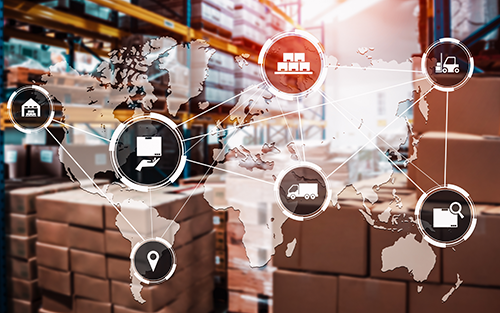- By Tejaskumar Vaidya
- October 09, 2025
- Feature
Summary
In the evolving landscape of supply chain management, AI is shifting from theory to tangible applications.

The decision making process, which includes demand planning, supply planning and scheduling execution, is a crucial step in every supply chain planning process. Traditionally, the supply chain decision making process involves human judgements with calculated assumptions. For example, demand planning occurs based on order history, stock on hand and foreseeable customer orders. Such processes are sequential and calendar driven to prepare final consensus demand plan (CDP).
Initial consensus forecast is comprised of the output of assumptions related to customer forecast, sales forecast, marketing forecast and statistical forecast. Preparing a final CDP process requires hours or even days of human efforts and manual intervention with high chances of deviation from expected outcomes, unfortunately!
Leveraging AI in supply chains to thrive in volatile markets
Artificial intelligence (AI) has been a focal point of discussion for years, but its influence is now moving from theory to tangible results across many industries. Many ERP suites are offering innovative, AI-based planning tools. In supply chain management, AI is transforming how businesses forecast demand, plan supply, manage inventory and optimize operations. Since preparation of precise demand plans has always been one of the most difficult aspects of supply chain management process, human collaboration still holds lot of value for any business success preparing quality demand plan.
In today’s dynamic market conditions, sporadic customer behavior and global geo-political situations affect supply chain planning. Traditional planning methods are less responsive to such disruptions. Without the benefit of perfect foresight, planners relied on primitive experience, quality of historical data for planning and of course, legacy ERP tools. AI changes this equation by processing vast amounts of data in real time, detecting subtle patterns while continuously learning algorithms from the latest available information. AI-driven forecasting models, along with statistical models, can deliver far greater accuracy than traditional models alone.
This allows businesses to anticipate demand shifts in advance while reducing excess inventory or stock out situations. Business can respond more effectively to supply disruptions in a timely manner with lot more agility and efficiency to stay ahead.
The power of human oversight in AI-driven supply chain planning
Supply chains must evolve to become more resilient by integrating AI with human expertise. Machine leaning algorithms can highlight trends and generate recommendations, but experienced planners bring the context, judgment and strategic thinking needed to interpret those insights. When technology and human decision-making process work in collaboration, supply chains can achieve new levels of resilience, efficiency and responsiveness. Experts suggest integrating machine learning at the digital twin level to achieve more accurate forecasting, anomaly detection and autonomous decision optimization while preparing scenario planning considering what- if analysis. It is important to design human-in-the-loop sort of solutions considering factors like how human oversight and trade-off get balanced while decisions are critical.
Supply chain and Industry 4.0 revolution through AI
In general, AI influence in supply chain processes involves automatizing data analysis process with minimal repetitive, time-consuming tasks being carried out during sales and operations planning process. AI is the emerging technology that utilizes human intelligence through AI/ML methodology to solve complex tasks with quick response, accuracy and efficiency. Integration of AI can help planners focus more on value added tasks while AI taking care of monotonous repetitive data management.
On the other hand, Industry 4.0 involves synchronized planning across multiple downstream processes like shop floor operations, inventory postings, production execution, receiving and shipping. Industrial 4.0 transformation involves IoT devices and sensors for collection of real time data from machines, vehicles and labor pool, which can be leveraged to transform into automated processes and actionable insights. Engaging IoT and operational data dynamically into core business processes like engineering, manufacturing, logistics, maintenance and service to create real-time feedback across various operations, enables businesses to improve productivity and respond more quickly to changing conditions. Combining enterprise data and IoT data and embedded AI will help automate processes and provide greater visibility, increasing efficiency at each stage of the product life cycle. Smart sensing, big data management, edge computing, analytics and AI are revolutionizing industry with human collaboration.
Empowering solutions for chronic issues with AI assistance
Supply chain could have hundreds of problems with demand, supply and inventory levels influenced by multiple factors. Manufacturers need to focus on the most important variables. AI helps planners to cut through excess noise to receive important demand signals. Demand sensing and machine learning dives through huge data sets and identify demand drivers to predict future trends.
Similarly, on the supply side, identifying optimal source of supply which provides better cost, customer services and sustainability to fulfill demands on time brings numerous headwinds to planner’s daily tasks.
Inventory levels balance for SKUs with high runners versus low runners presents another complexity in supply chain. AI-assisted ERP solutions, such as multi echelon inventory optimization (MEIO), analyze historical sales and markets trends for precise forecasting to optimize inventory levels across diverse product groups. Sophisticated "what-if" scenario planning through AI integration helps compare and prepare strategic budget planning for various cases. Traditionally, these analyses can take up a lot of time. Modern tools like SAP IBP utilize centralized cloud data pools from various sources to perform such analysis interactively on the fly.
AI brings lot of value to enterprise planning. However, continuous volatility, market trends, tariffs and geopolitical situations keep changing the game, keeping manufacturers on their toes. AI-based dashboards powered by data analytics tools can monitor exceptions and constantly evolving trends, improving visibility and overall efficiency.
Unlocking innovation: The power of AI and human collaboration
AI is undeniably emerging as the most powerful tool for enterprise planning processes. However, it's important to remember that AI is best as an assistant rather than a replacement for human workers. The greatest benefits of AI are realized when it is used in tandem with human expertise, as this collaboration unlocks innovative solutions and drives superior results. Organizations that integrate human knowledge and judgement with AI’s strengths can adapt quickly and gain a meaningful edge in rapidly changing markets.
About The Author
 Tejaskumar Vaidya is a Sr SAP APO/S4 HANA consultant/solution architect at AdvanSoft International. He has more than 16 years of experience in Enterprise Resource Planning (ERP) IT implementations and global roll outs, with a focus on applying industry specific supply chain solutions to modernize ERP technologies through SAP APO (Advanced Planning and Optimization), SAP S4 HANA, SAP IBP and SAP ECC. His cross-industry impact spans to various industrial sectors like Pharmaceuticals, Automotive, Food & Beverages and medical device manufacturing, where he has consistently delivered operational improvements through digitization and IT transformation of legacy systems into efficient, transparent and user-friendly solutions targeted for Advanced Production Planning & Scheduling, Supply Network Planning as well as Demand Planning functions including AI-driven automation and smart digital platforms.
Tejaskumar Vaidya is a Sr SAP APO/S4 HANA consultant/solution architect at AdvanSoft International. He has more than 16 years of experience in Enterprise Resource Planning (ERP) IT implementations and global roll outs, with a focus on applying industry specific supply chain solutions to modernize ERP technologies through SAP APO (Advanced Planning and Optimization), SAP S4 HANA, SAP IBP and SAP ECC. His cross-industry impact spans to various industrial sectors like Pharmaceuticals, Automotive, Food & Beverages and medical device manufacturing, where he has consistently delivered operational improvements through digitization and IT transformation of legacy systems into efficient, transparent and user-friendly solutions targeted for Advanced Production Planning & Scheduling, Supply Network Planning as well as Demand Planning functions including AI-driven automation and smart digital platforms.
Did you enjoy this great article?
Check out our free e-newsletters to read more great articles..
Subscribe

